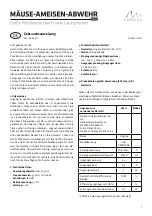
IOM manual Active pulsation dampeners
8
2.
MAINTENANCE
STOP
!
!
Fig. 2.4.1.
By means of a screwdriver, remove the circlip [27] and muffler [25].
Fig. 2.4.2.
Remove the nut covers [579] from the dampener housing and block.
2.1.
When dampener is new or re-assembled
If the dampener is new or re-assembled after maintenance it is important to re-tighten the
dampener housing screws (pos. 37) after a few days of operation. Make sure to use the right
torque, see chapter 4.2.
2.2.
Routine inspection
Frequent observation of the dampener operation is recommended to detect problems. A change in
sound of the running dampener can be an indication of wear. Leakage of liquid from the dampener
and changes in performance may also be detected. Routine inspections should be conducted
frequently.
2.3.
Location of faults
PROBLEM
POSSIBLE FAULT
The dampener does not work
The air connection is blocked
The diaphragm is damaged
The muffler is blocked
There is dirt in the dampener chamber
Liquid leaks from the dampener
Screws on the housing are not properly tightened
Liquid comes out of the muffler
The diaphragm is damaged
2.4.
Dismantling the dampener
The numbers put in brackets, refer to the part numbers in the spare parts drawing and spare parts
list in chapter 3.
Before the dismantling procedure
Be sure to drain all liquid from the dampener. Cleanse or neutralize the dampener thoroughly.
Disconnect the air connection and then the suction and discharge connections.








































